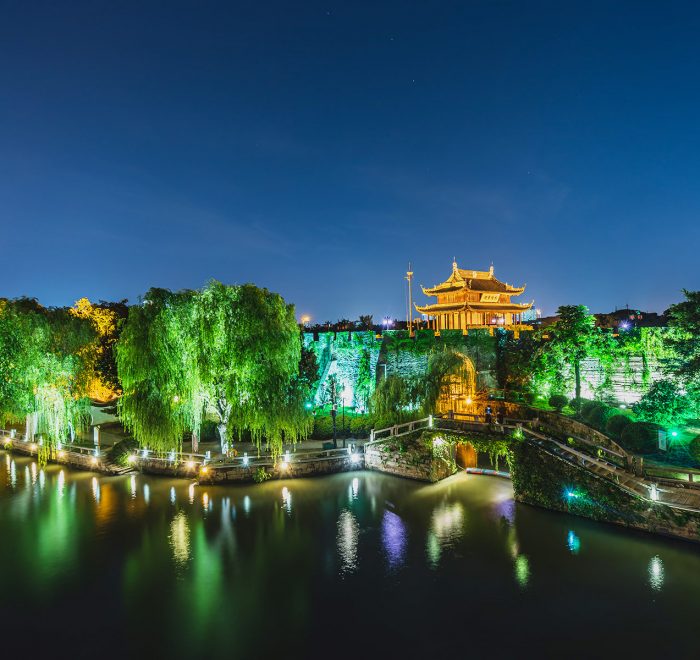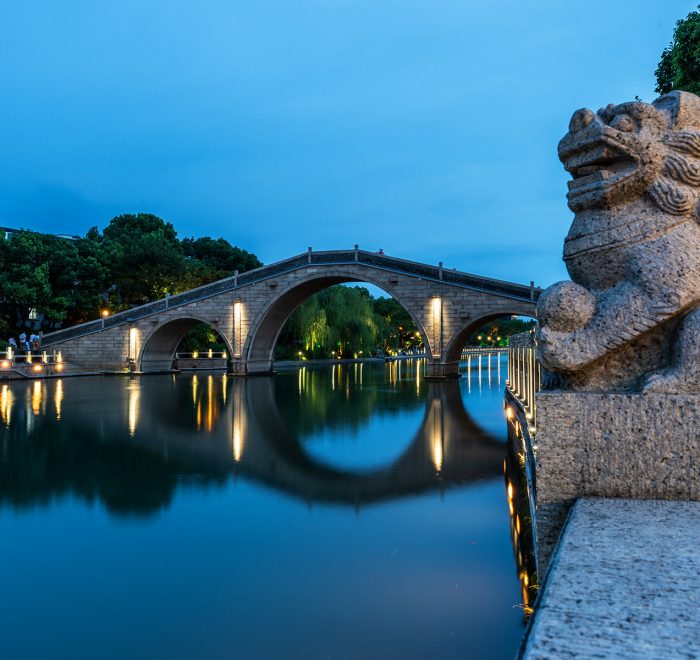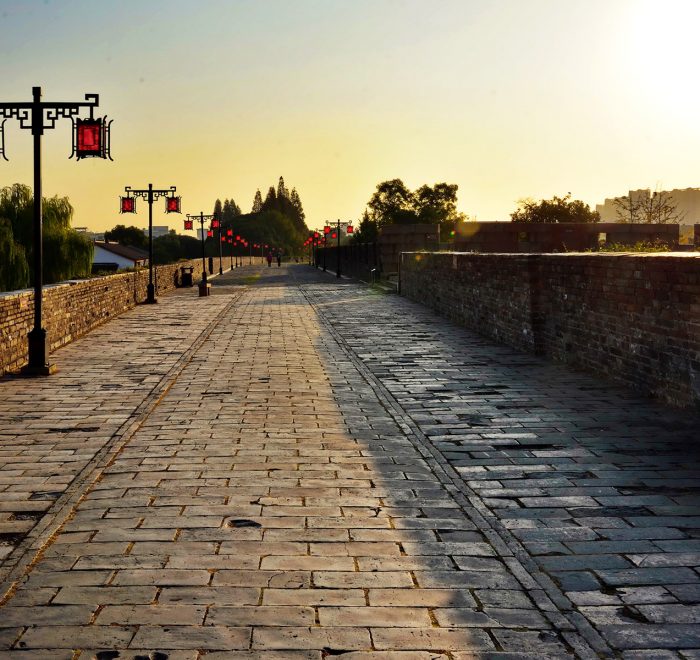Présentation de la zone scénique de Panmen
La zone scénique de Panmen se situe au sud-ouest de la vieille partie de Suzhou, avec le Wugong Pan-Pacific Grand Hotel et la rue Xinshi juste au nord, et la rivière Huancheng au sud. La zone scénique de Panmen comprend trois sites célèbres, Les portes de la ville terrestre et aquatique, La pagode Ruiguang, et le pont Wumen. La nouvelle zone scénique de Panmen a été officiellement ouverte au public en septembre 23, 1999. Lorsque la réunion des ministres des finances de l'APEC a eu lieu à Suzhou, en septembre 2001, la salle Sirui de la zone scénique a été choisie comme lieu de l'événement.
Informations rapides sur la zone scénique de Panmen
• Nom Chinois: Panmen Jingqu 盘门景区
• Meilleure période pour visiter: D'avril à octobre
• Heures de visite recommandées: Environ 2 à 3 heures
• Activités à faire: Photographie, Architecture, Histoire et culture
• Heures d'ouverture: 07:00-17:00 (Jour); 18:00-20:00 (Nuit)
• Frais d'entrée: ¥40 (Jour) / ¥40 (Jardin de nuit) / ¥6 (Monter à la pagode)
• Adresse: No. 49 Avenue de l'Est, District de Canglang, Suzhou, Province du Jiangsu
À quoi s'attendre à la zone scénique de Panmen
Porte de Panmen, which is under a provincial relics protection unit, was one of eight prominent gates in old Suzhou and was built in 514 BC. Panmen Gate got the name Panmen from a wooden carving, a Pan Long (coiled dragon) at the top of the gate to frighten State of Yue. It later got the name Panmen Gate, meaning winding (dragon) gate. The current gate was built during the Yuan Dynasty, and the gate tower was refurbished in the summer of 1986. The Panmen Gate consists of two gates on the water route, and two on land, as well as an enclosure between the inner and outer gates, gate towers, and city walls going out from the gates. Panmen Scenic Area is the only well-preserved land and water gate in Suzhou and in China for that matter.
Land-and-Water City Gates
The land gates have an inner and outer part, avec une enceinte à l'intérieur pour cacher les troupes afin de combattre l'ennemi. Les portes d'eau et les portes terrestres sont étroitement liées, avec des parties intérieures et extérieures, aussi, et des approches cachées vers les tours. Elles sont toutes deux équipées d'un grand herse qui, dans les temps anciens, pouvait être levée ou baissée pour contrôler le passage des personnes ou des bateaux afin de défendre la ville.
Mur de la ville & Pont Wumen
Les murs sont accessibles depuis le versant nord et offrent une vue panoramique sur l'ensemble de la structure, tant les portes terrestres que les portes d'eau. Les murs de la ville étaient bien équipés pour défendre la ville, avec des créneaux, des canons, des meurtrières, des trous pour tirer, des entrées verrouillées, des portes, et un moyen de prévenir les incendies. L'eau courante au-delà de la Porte Panmen avait une importance stratégique pendant les guerres dans le passé. So there is an inscription on the Panmen gate tower announcing that it is, Key to the Central State of Wu. There are also opposing couplets reading, “City walls of ancient Wu are thick and solid, swords and flames are often brought to the capital.” A visitor can hardly help being a bit nostalgic while examining the couplets and historical relics. The Wumen Bridge, which is adjacent to the Panmen Gate and crosses the old Grand Canal, was first built during the Song Dynasty and rebuilt during the Qing, so it has a history of 130 years and is Suzhou’s only single-arch stone bridge still standing. Panmen Scenic Area is now a cultural relic under municipal protection. Panmen Scenic Area resembles a full moon and is 66 meters long, 16 meters along the clear span of the arch, and 9.85 meters on the arch rise. The southern and northern steps are paved with slate and supported with carved stone on both sides. The bridge has a light, graceful structure that is a good example of the features of bridges in waterside towns along the Yangtze River.
La pagode Ruiguang
The 13-storey Ruiguang (Auspicious light) Pagoda, in the Puji Temple, was built by Sun Quan during the Three Kingdoms period (AD 220-280) as a way to repay maternal love. It is also known as Bao’en (Paying for maternal love) pagoda, and was the earliest Buddhist pagoda in Suzhou. According to a popular legend, the pagoda could give off multi-colored light. During the Song, Yuan Zhao, an eminent monk, would lecture on abstruse parts of Buddhist sutras so wondrously that the temple was the site of four auspicious omens — the drums in the hall chimed by themselves; Les bambous flétris dans la cour sont devenus verts; Une tortue blanche dans l'étang écoutait les enseignements du Zen; et la pagode émettait une lumière multicolore. L'empereur Huizong de la dynastie Song ordonna qu'une tablette horizontale portant l'inscription 'Temple Ruiguang' soit réalisée. Ainsi, la pagode Bao'en devint la pagode du Temple Ruiguang.
La pagode telle qu'elle est aujourd'hui a été construite durant la première année de Jingde sous la dynastie Song du Nord (1004). Elle mesure 53.6 ... mètres de haut et a sept étages et huit côtés. La pagode se rétrécit vers le haut suivant une ligne courbée. Elle présente une simplicité primitive, mais est délicate et douce, et montre le style et les structures d'une pagode des dynasties Tang et Song. Son corps principal a été construit en briques datant de la dynastie Song. Le troisième étage constituait le noyau de la pagode. Dans 1978, a “heavenly palace” was found hidden in the storey, containing precious relics. The pagoda has an ingenious structure and has great historical, artistic and scientific value. In Jan 1988, the State Council added it to a third group of key cultural relics under national protection.
How to get to Panmen Scenic Area
• Prenez le bus n°. 39, 935, 949, Ligne touristique 2 or Line 5 and get off at Panmen Scenic Area North Station.
• Prenez le bus n°. 921 and get off at Xinshiqiao South Station.
Additional travel advice on Panmen Scenic Area
• Tourist Center is at the east entrance of the scenic area, offering multiple services: Information Inquiry, Baby stroller/Phone charger/Wheelchair lending, etc..
• The entrance ticket includes boating (environ 10 minutes) for sightseeing.



